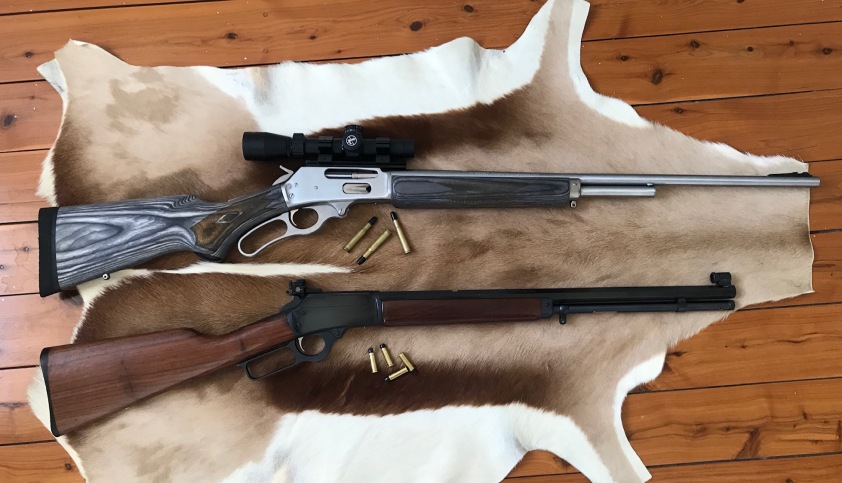
Marlin XLR 336 vs Connecticut era JM Marlin 1894CB
You might be wondering why one would purchase a (comparatively) expensive Marlin XLR 30-30. That’s an astute observation as similarly priced modern levers such as the Browning BLR or Henry Long Ranger in such chamberings as the 308w should always outperform ye olde 30-30. Nevertheless, there’s a few reasons for choosing an upgraded 30-30 over the modern Winchester 88 spin-offs:
- Both the modern BLR and Henry LR sport inherently heavy triggers. Based upon the front-locking, Winchester 88 rack-and-pinion design, the trigger linkage on these actions are complex and heavy. Sure they can be lightened, but this demands a visit to a gunsmith. Even then, results can be varied, as they are generally considered to be a more complex trigger to SAFELY lighten. The 336 trigger on the other hand is simpler, and can easily facilitate aftermarket triggers. If the trigger break is important to you (like it is for me), the 336 action is a better choice.
- A longer 24″ lever gun is a hard thing to come by these days. In many cases one is forced into the (expensive) resale market. And both the BLR and Henry LR are currently only available as 20″ carbines. This is fine if you only intend on scoping, but if iron-sights are your jam, you’ll appreciate the longer sight radius of a 24″ barrel. And of course I should mention that unlike your average Winchester 94, Marlins eject sideways and come pre-drilled and tapped to easily take a rail.
- Whilst the 308w is a superior round, the 30-30 (shooting modern projectiles) is in reality not so far behind. Driven at 2300fps+ (which can be achieved with the longer 24″ barrel) it’s wind-bucking ability is not to be scoffed at. From a capable marksman shooting the Hornady Flex-Tip projectiles (with the higher g1 ballistic coefficient of 0.33), the XLR can comfortably 5-shot group into 6″ at 300m.
- The XLR’s slower 1:12 ballard-style cut-rifling really does seem to stabilise (specifically) the Hornady Flex-Tip projectiles exceptionally well, in fact better than any 30-30 I’ve ever seen. And (arguably) the ballard rifling should stabilise cast lead bullets better than the modern 1:10 microgroove barrels (which you will find in most 336’s). And cast-lead pills through ballard-rifle lever guns is highly documented. These days there’s more information online about the subject than you can poke a stick at. If you want to sling cheap cast-lead pills, the XLR will be better suited than the BLR or Henry LR.
- And with regard to “silly-wet” target shooting, I’d like to mention that often Lever Action Silhouette rules stipulate rifles must be traditionally styled with the under-barrel magazines. The BLR and Henry LR will not conform to such requirements.
Ok, so with such reasoning out of the way, onward with the review!
NOTE: As a previous owner of an entry-level 336, the following review focuses more on a comparison between a cheaper 336 and the upgraded XLR336.
These days the Marlin XLR comes out of the same factories as the “cheap” remlin versions, so I was a little nervous it wouldn’t be much of a step up from my cheaper 336w (yet costing around double the price!). Thankfully, the first thing I noticed was that compared to the entry level 336, the fit and finish is of an obviously higher standard. The machining is a bit more refined than the 336w; less sharp edges and the action is fairly smooth out of the box, yet still locks up tight. The tolerances are noticeably tighter; some of my rough old handloads are a squeeze to chamber; I’ll need to tweak my trims and OALs to suit this rifle. From a weight and balance perspective, the XLR feels very similar to my old 336w, with little more weight up front. The factory trigger is also significantly lighter and crisper than your average 336, breaking cleanly at around 3.5lbs. Probably about perfect for a hunting rifle. Unfortunately the factory trigger still suffered from the dreaded marlin flop. NOTE: I replaced my factory trigger with the drop in “Wild West Guns: Trigger Happy Kit” trigger, as this gun will be used for target shooting – after all I do like my aftermarket triggers!
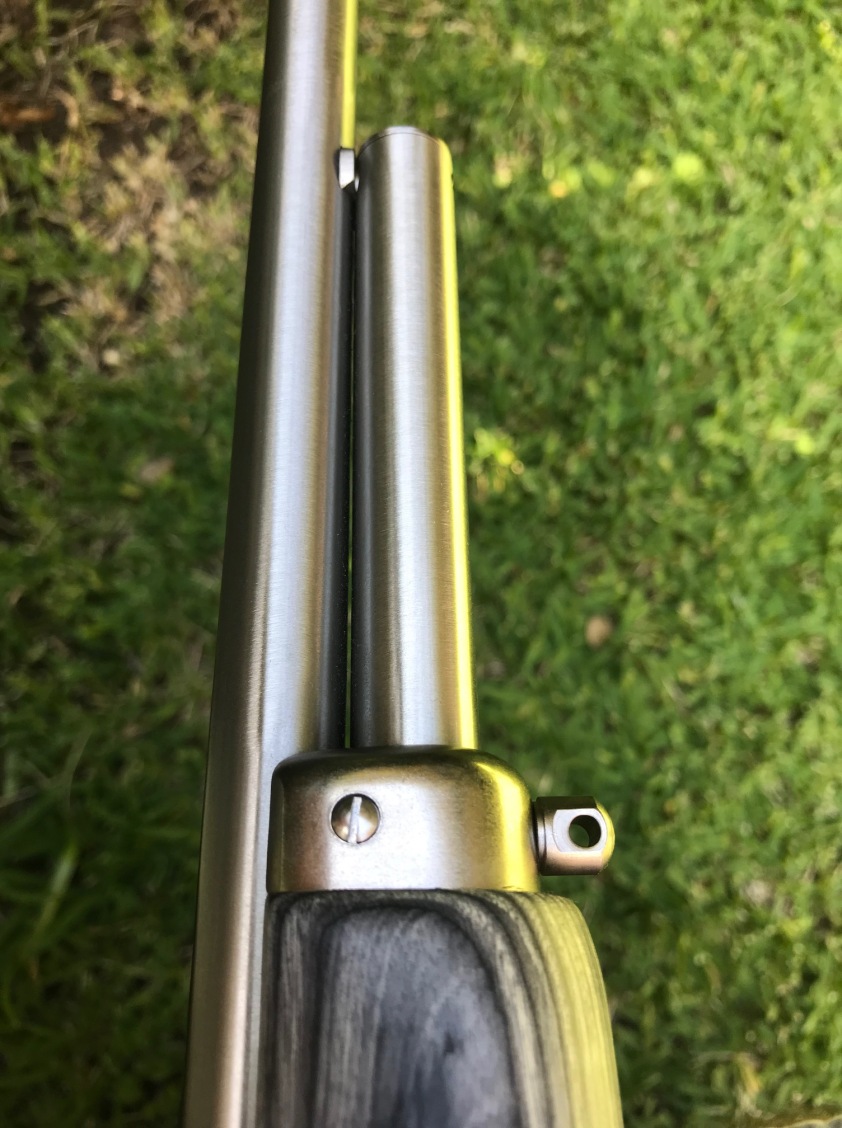
The 5-shot magazine captured by a forend cap and dovetailed hanger instead of barrel bands helps with accuracy

Timber finish is the best I’ve seen on a new-era Marlin
The squishy Pachmayr, recoil absorbing butt plate is finished perfectly, and does a superb job at soaking up any felt recoil from even the hottest of factory loads. It’s on-par, if not better than the aftermarket Limbsaver pad I had to add to my 336w:
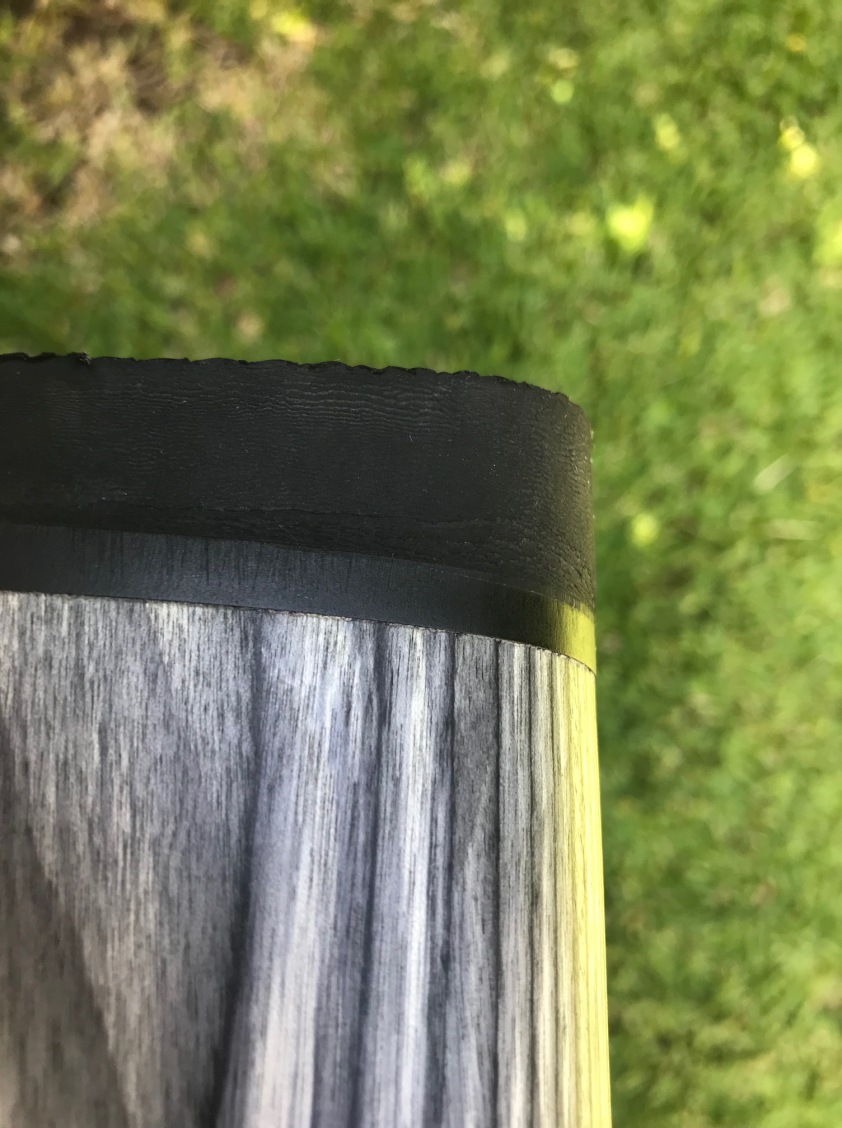
Recoil pad finished perfectly
Even though it’s a laminated timber stock, the colouring and checkering is well finished. A small polymer cap underneath the grip I discovered is also a nice touch and oozes quality:
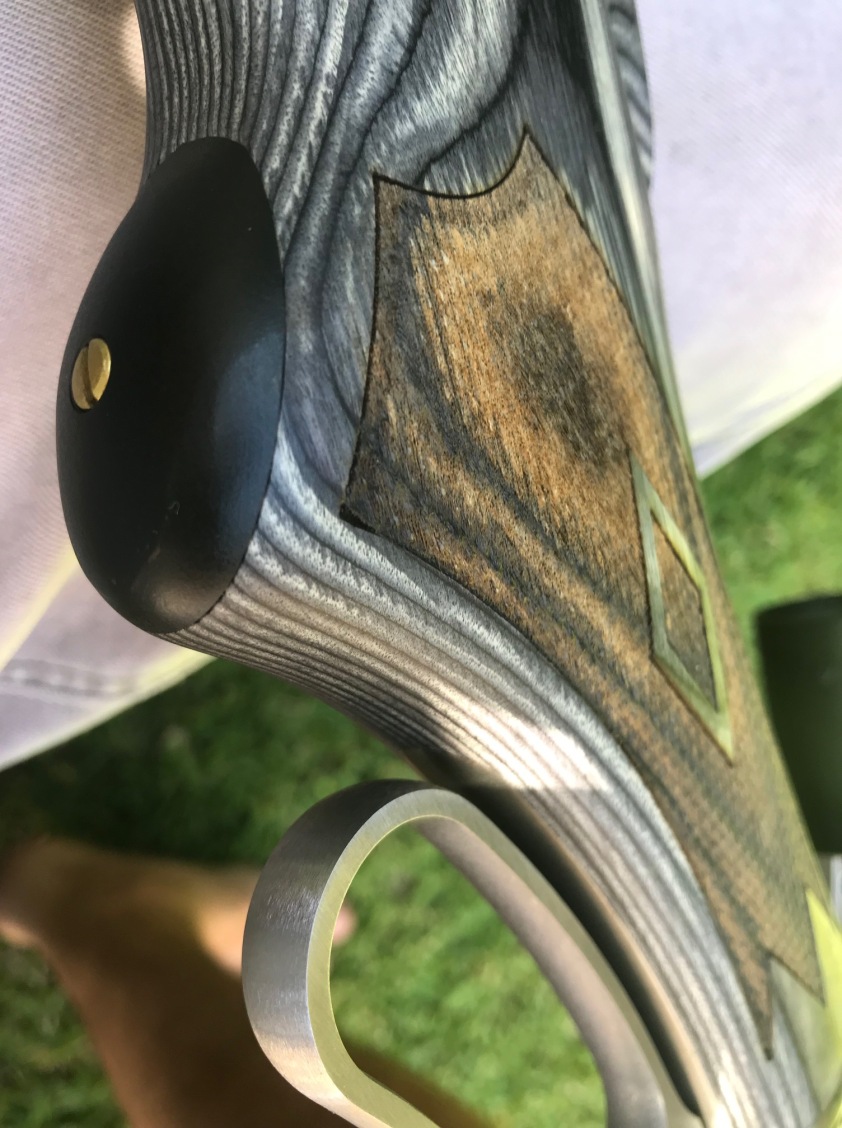
The bolt is fluted, reducing the bearing surfaces and thus helping with an overall smoother action:

Fluted bolt reduces bearing surface
The underside of the bolt showed an embossed “3030” insignia, another touch of quality:
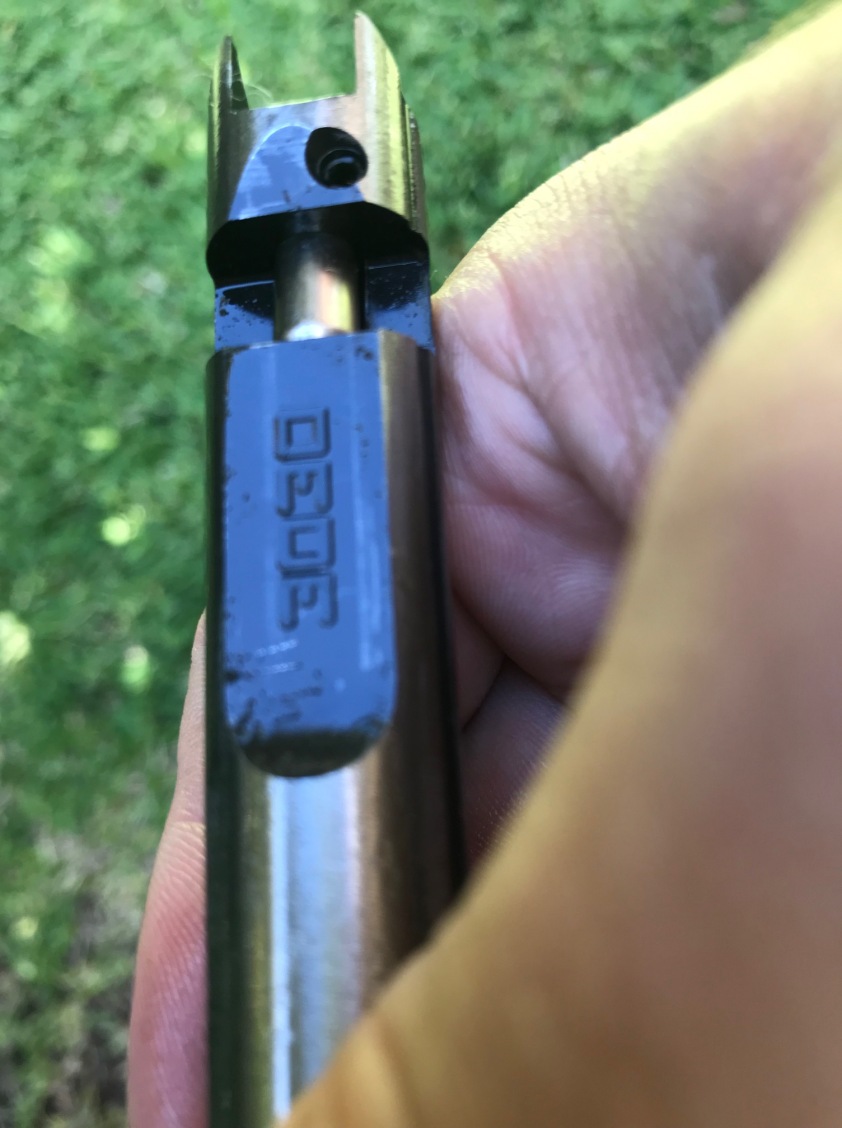
Another touch of quality
The screw-attached front ramp that is dovetailed to take the front sight has two screws (instead of just the one as you see on the budget 336 models) meaning I was comfortable changing the front sight without worrying about damaging any screws. This was a real bug-bear for me in the past when changing front sights:

Two screws for the front sight much sturdier
With a box of Hornady Leverevolution factory ammo, the XLR 5-shot grouped very tidily indeed. Sporting a little 1-4×24 scope at 50m, the first three shots stacked sub-moa on top of each other, then the fourth and fifth opened up to just under 2moa. This is undoubtedly due to the barrel properties changing from the heat generated by the hot hunting loads (after all, it’s no free floating barrel!):
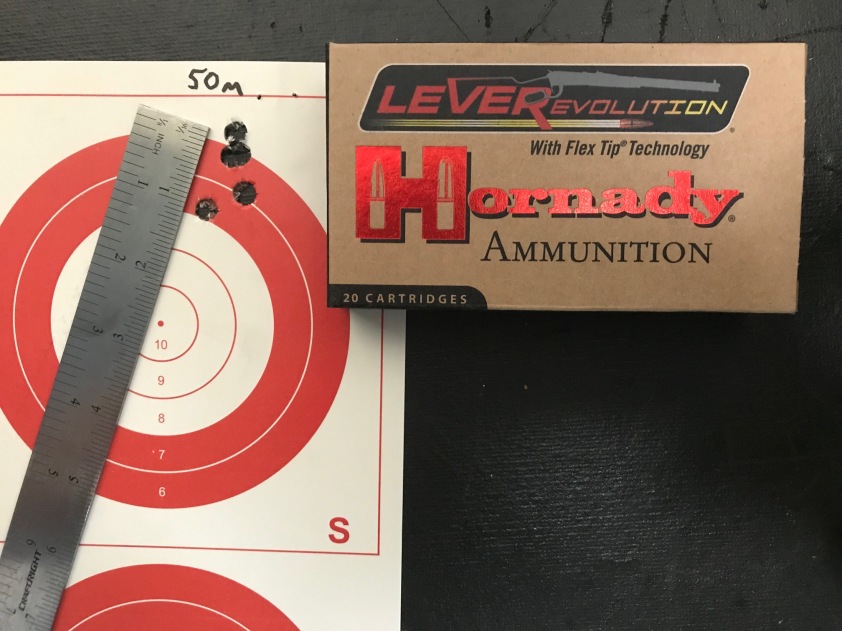
Hornady Leverevolution 50m group
Beyond 5-shots the gun has a strong tendency to string vertically. This is common for a lever gun due to the direct contact between the timber forend and barrel. As the barrel and action heats, the barrel has a tendency to expand and move away from the timber, thus resulting in a vertical wandering point of impact. The wandering direction can seem counter-intuitive, however remember that any barrel taper can impact such characteristics. In fact this problem can be mitigated through a bit of home tinkering by RTV silicone-bedding the forend, but that’s a subject for another day!
Working up handloads, 21 grains of AR2207 under a 150gr plated bullet with a muzzle velocity of around 1800fps groups south of 2moa, encroaching on the 1moa mark:
And 25 grains of AR2206H also with a muzzle velocity of ~1800fps also groups consistently into around 2moa, even with a piping-hot barrel, which has real potential as a longer-range target load.
Interestingly my XLR didn’t seem to like the milder Trail Boss or AP70N loads, the rifle actually displayed quite a lot of vertical stringing down the lower end. Nonetheless AR2207 seems like the forerunner when it comes to powder choice , and certainly shoots above average for the 336.
Overall I was encouraged by the quality of the Marlin XLR 336; the attention to detail is where the XLR far surpasses your average 336. And it’s fair to conclude that the XLR is up there amongst the most accurate out-of-the-box lever action rifles. But at $900USD+ MSRP, you’d bloody hope so!!

